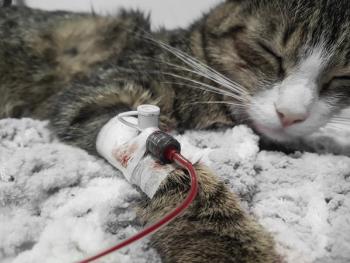
Are three round incisions in kidney a diagnostic clue?
Signalment: Canine, Chinese Shar Pei, 3-year-old, female, 41 lbs.
Signalment:
Canine, Chinese Shar Pei, 3-year-old, female, 41 lbs.
Clinical history:
The dog had a vaginal mass removed three weeks ago. The histopathologic report indicates the vaginal mass is a grade 3 mast cell tumor.
Table 1: Results of laboratory tests
Physical examination:
The findings include rectal temperature 101.8° F, heart rate 110/min, respiratory rate 35/min, pink mucous membranes, normal capillary refill time and normal heart and lung sounds.
Laboratory results:
A complete blood count, serum chemistry profile, and urinalysis were performed and are outlined in Table 1, p. 16S.
Radiographic review:
Survey thoracic and abdominal radiographs were done.
Radiographic review(photos):
My comments:
The thoracic radiographs are normal. The abdominal radiographs show a prominent spleen.
Ultrasound examination:
Thorough abdominal ultrasonography was performed. The dog was positioned in dorsal recumbency for the ultrasonography.
My comments:
The liver shows inhomogeneous texture. A hypoechoic mass-like area with mixed echoes and hypoechoic center is present in the left lateral liver lobe. FNA from this area was obtained for cytologic examination. More mass-like areas with same ultrasonographic texture are present throughout the liver parenchyma.
Ultrasound examination(photos):
The gall bladder is mildly distended, and its walls are not thickened or hyperechoic. The gall bladder does contain some sludge material. The spleen is slightly enlarged and shows inhomogeneous texture. Some irregular hypoechoic lesions are present within the splenic parenchyma. There is also possibly a reactive splenic lymph node. The left and right kidneys are similar in size, shape and echotexture. Each kidney shows inhomogeneous texture.
The left kidney contains two or three round hypoechoic lesions in its renal cortex. The right kidney shows a mildly dilated renal pelvis. No masses or calculi were noted in either kidney. The urinary bladder is distended with urine and contains some urine sediment material - no masses or calculi noted. The wall of the urinary bladder may be slightly thickened. An anechoic tubular structure with a thickened echogenic wall is visualized at the level of left lower abdominal quadrant cranial to the urinary bladder and is compatible with fluid-filled left uterine horn.
The left and right adrenal glands are similar in size and shape. The stomach, small intestines and colon are normal. The pancreas shows decreased echogenicity and inhomogeneous texture.
Case management:
In this case, intra-abdominal neoplasia is the clinical diagnosis. The intra-abdominal neoplasia is probably related to the previous history of excised mast cell tumor. After confirmation of an intra-abdominal mast cell tumor, I would perform medical therapy for the mast cell tumor.
Mast cell tumor review
When a mast cell tumor appears in the axilla, mammary tissue, groin, perineum, or genitals or in any of the mucocutaneous tissue, the tumor usually acts as a grade 3 mast cell tumor with metastatic intentions. Intraoperative radiation therapy and intralesional depo-medrol or triamcinolone are adjunctive therapies that may also enhance the possibility of successful excisional surgery.
All dogs receiving chemotherapy for cancer require regularly scheduled CBCs to monitor for drug-induced myelosuppression. Chemotherapy protocols for mast cell tumors in dogs vary with the severity of disease. Prednisone at 40 mg/m2 orally q48h for 10-14 days then 20 mg/m2 q48h along with chlorambucil at 4-6 mg/m2 orally q48h for maintenance of dogs with mild clinical disease. Vinblastine at 2 mg/m2 or vincristine at 0.7 mg/m2 intravenously weekly for six times and then every other week for six times, and every three weeks as maintenance may be added to the previous protocol for high grade or metastatic disease. If chlorambucil is not effective, cyclophosphamide at 200-300 mg/m2 given orally during a 4-day period may be used on the alternate weeks when not using vinblastine or vincristine. For severe disease, lomustine at 50-85 mg/m2 orally divided over four days every three weeks is an additional approach. Lomustine causes significant myelosuppression after three or four treatment cycles; therefore, increasing the interval between treatments to five weeks to eight weeks seems to help the myelosuppressed dog.
Newsletter
From exam room tips to practice management insights, get trusted veterinary news delivered straight to your inbox—subscribe to dvm360.




